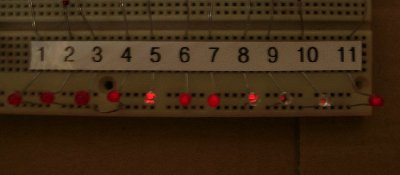
Above: Power supply = 1.5V. (390R series resistors). LED's (5) and (8) are brighter than (6), (7), (11) which are brighter than (4), (9), (10). Note: (1), (2) and (3) are off.
INTRODUCTION
Light Emitting Diodes (LED's) have replaced bulbs in many appliances (eg. Fridges, TV's, Radios, Videos, clocks, tapes players ... etc. etc.). They take very little electrical power, last for years without failing and are cheap. They are excellent little indicators for a whole host of experiments and gadgets. For examples see the experiments below:
shake-a-gen
rectifier and storage device
sea water battery
Although they are cheap and available there seem to be so many different types how do you know which one to use? The purpose of this little article is to compare a number of common LED's and see how they match up with each other. A question I wanted to ask was - are the LED's that are sold as very bright (eg. UltraBright) only useful in high power applications or are they just better all round ?
The 11 LED's compared were:
| LED No. | Description | Code* | mcd (mA) | Series |
| (1) | standard red | 55-0102 | 3 (10mA) | L-934 |
| (2) | standard bright | 55-0150 | 50 (10mA) | L-934 |
| (3) | standard red | 56-0740 | 3.2 (10mA) | L-34 |
| (4) | superbright | 56-0505 | 200 (20mA) | L-934SRD |
| (5) | superbright | 72-8976 | 2500 (20mA) | L-934S |
| (6) | superbright | 72-8978 | 400 (20mA) | L-934S |
| (7) | superbright | 72-8980 | 1300 (20mA) | L-934S |
| (8) | ultrabright | 56-0540 | 1000 (20mA) | L-934SRC |
| (9) | hyper red | 72-8940 | 1300 (20mA) | L-934SURC |
| (10) | hyper red | 72-8942 | 2000 (20mA) | L-934SURC |
| (11) | low I Super Red | 56-0415 | 20 (2mA) | L-934L |
NOTES: all LED's are 3mm red types, codes are the RapidElectronics order code, mcd = light o/p (in milli candela - is dependant on the current (mA in brackets)), all LED are made by Kingbright and the particular range (series) is shown for each LED in the last column.
TEST ONE - LOWEST OPERATING VOLTAGE
In this test each LED was wired in series with a 390R resistor and the 11 circuits wired to a veriable power supply. The voltage was set to about 3-4V and then slowly reduced till the first LED went out and the voltage measured. This was done till all the LED's went out. The results are of interest as a comparsion only.
RESULTS
LED 3 was the first to go out at 1.73V
LED 1 was next at 1.69V
LED 2 was out at 1.60V
The rest, LED 4 to 11 went out around 1.50V
TEST TWO - LIGHT OUTPUT v VOLTAGE
With the same set up as in test one the voltage was set at 1.5, 2, 3, 4 and 5V (applied across each LED 390R resistor series circuit). The brightness for these 'constant' voltages were then compared.
In all the pictures shown below LED (1) is on the far left and they go through to LED (11) on the far right. Note: these pictures are only meant to give a rough indication of the relative brightness of the LED's.

Above: Power supply = 1.5V. (390R series resistors). LED's (5) and (8) are brighter than (6), (7), (11) which are brighter than (4), (9), (10). Note: (1), (2) and (3) are off.
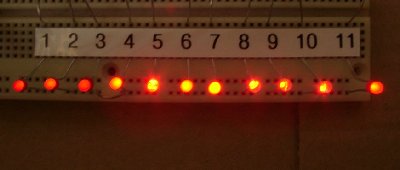
Above: Power supply = 2V. (390R series resistors). (5) to (9) are brighter than (4), (10), (11) which are brighter than (2), (3) which which are brighter than (1).
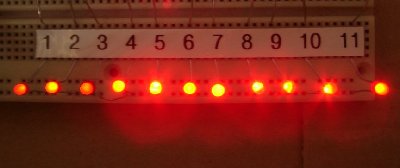
Above: Power supply = 3V. (390R series resistors). (5) to (8) are about the same and brighter than (4), (9) to (11) which are brighter than (2), (3) which are brighter than (1).
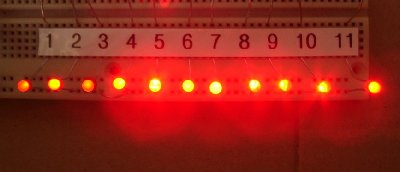
Above: Power supply = 4V. (390R series resistors). (5) to (8) are brighter than (4) and (9) to (11) which are brighter than (1), (2) and (3).
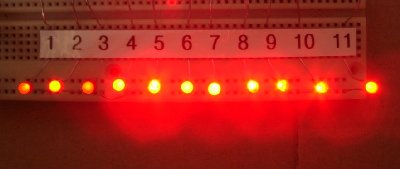
Above: Power supply = 5V. (390R series resistors). (5) to (8) are brighter than (4), (9) to (11) which are brighter than (1), (2) and (3).
TEST THREE - LIGHT OUTPUT v CURRENT
In these simple tests the series resistor limits, and roughly sets, the current flowing in each LED circuit (the current being depenednt on the voltage). As all series resistor are the same value all the LED's will have very nearly the same current flowing. As a last test I checked to see the effect of making sure each LED was being supplied with exactly the same current. This was done by wiring each LED with a fixed and preset resistor in series (390R + 1k veriable) and the preset was adjusted so that each LED had the same current flowing in its own circuit (for the particular voltage applied to the system). This way each LED was adjusted independantly to have the same current flowing. The procedure was repeated for 1, 2.5 and 5mA and the light ouput compared for the LED's.
RESULTS
There was no major difference from the results in test 2 above.
SUMMARY
Although all LED's No. (5) to (8) are very much in the lead as far as light output is concerned the all round best is probably the superbright LED No. 5 . These high output LED's are far better than the standard red LED (1) and seem to give out more light on lower voltage and less current (less power overall) than the standard. These LED's will work very well in the Sea water battery and the shake-a-gen (and especialy good in the shake-a-gen 'storage device') experiments.
ABOUT LED's
A diode is a two wire component that only passes current when the voltage is applied correctly across it. Reverse wiring passes no current and for small voltages the device will act as a standard diode but it will brake down when higher voltages are applied. The LED, or Light Emitting Diode produces light when a current (usually 1-20mA) is passed through the device in the forward direction.
Unlike a resistor, the current flowing through a diode is not linearly dependant on voltage. In fact the current will go up exponentialy with the applied voltage. This means that at the 'light turn on' voltage (say 1.8V) a small current might flow (~10mA) but the applied voltage has only to increase by a few 0.1V's and the current can rise considerably (~100mA's). The current therefore needs to be limited to stop the LED burning out. This is simply done using a series 'dropping' resistor. The value of the resistor is given by the supply voltage minus the LED voltage (ca. 2V) divided by the LED current (~10mA), or roughly 100R for every volt, (ie. roughly 600R for 6V and 1k for a 9V battery). You can play around with the value by a factor of 2 or so to get more light o/p, its not too critical for most LED's (apart from the very high power ones).
THE CREATIVE SCIENCE CENTRE
home | diary | whats on | CSC summary | latest news